If you’re searching for the best color-grading monitors in 2025, I’ve got you covered with top picks like the ASUS ProArt 34” Ultrawide, BenQ PD2705UA, Dell UltraSharp U3223QE, and ViewSonic VP3881. These models offer wide color gamuts, high resolutions, and factory calibration for accurate results. Portable options like the 15.6” OLED monitor are perfect on the go. Keep an eye out for my detailed guide to find the perfect fit for your workflow and budget.
Key Takeaways
- Highlights top monitors with high color gamut coverage, factory calibration, and HDR support for accurate video grading.
- Includes features like wide viewing angles, uniformity, and ergonomic design for professional editing workflows.
- Recommends models such as Dell UltraSharp U3223QE, ASUS ProArt PA27JCV, and ViewSonic VP3881 for 2025 needs.
- Emphasizes calibration tools and portable displays to maintain color accuracy across diverse editing environments.
- Guides on key considerations like cost, connectivity, and model limitations for optimal monitor selection.
DKK 5 x 7 Set of 2 White Balance and Color Calibration Charts
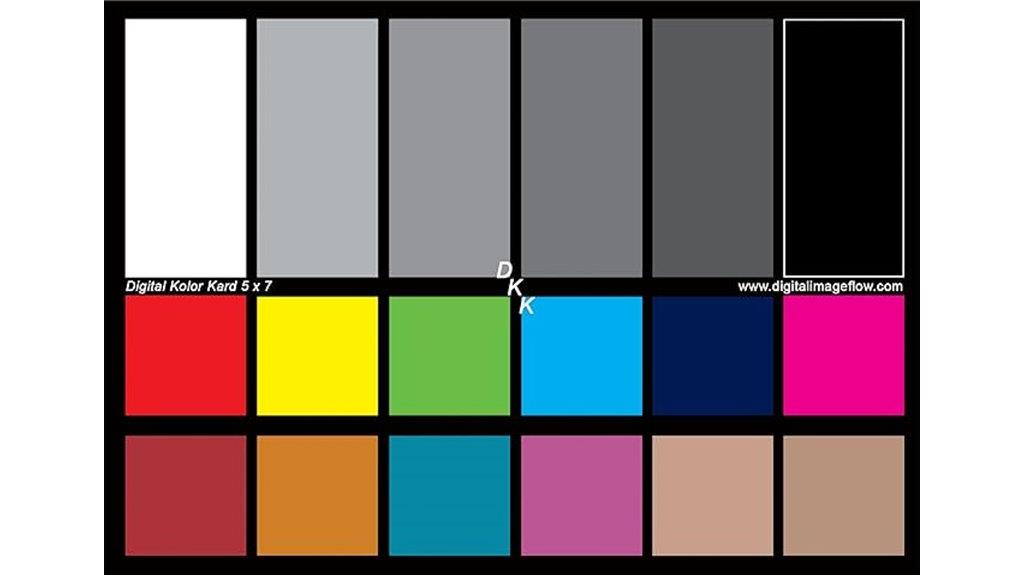
If you’re a professional or serious amateur photographer or videographer, the DKK 5 x 7 Set of 2 White Balance and Color Calibration Charts is an essential tool for ensuring accurate color reproduction. These charts feature 12% and 18% gray references, helping you achieve precise white balance, while the 18 color patches cover natural, chromatic, and primary colors for exhaustive calibration. Made with durable, archival-quality materials, they’re built to last through many shoots. The included frame stand and user guide make setup easy, and they’re compatible with editing software like Photoshop and Lightroom. This set guarantees consistent, true-to-life colors in your final work.
Best For: professional photographers, videographers, and serious amateurs seeking precise color calibration and white balance for high-quality digital imaging.
Pros:
- Includes both 12% and 18% gray references for accurate white balance calibration
- Features 18 color patches covering natural, chromatic, and primary colors for comprehensive color correction
- Constructed with durable, archival-quality, acid-free materials ensuring longevity and professional-grade performance
Cons:
- May be more expensive than basic calibration tools, potentially limiting accessibility for casual users
- Requires familiarity with editing software like Photoshop or Lightroom for optimal use
- The size (5 x 7 inches) may be less convenient for some portable or on-location shooting situations
Calibrite ColorChecker Video (CCVWB)

The Calibrite ColorChecker Video (CCVWB) stands out as an essential tool for video professionals seeking accurate color calibration on set. Its design features six saturated and six de-saturated color chips, along with four gray steps, making it perfect for in-camera white balance and color correction. Constructed from durable plastic, it’s lightweight and easy to handle during shoots. Users praise its ability to streamline multi-camera matching and facilitate automatic primary corrections, saving time in post-production. Although it lacks a hard case, its high accuracy, portability, and compatibility with most cameras and editing software make it a must-have for precise color control.
Best For: professional videographers and video production teams seeking accurate in-camera white balance and color calibration across multiple cameras.
Pros:
- Facilitates precise color matching and white balance adjustments directly on set
- Compatible with most video cameras and editing software for seamless workflow
- Lightweight, durable plastic construction makes it portable and easy to handle during shoots
Cons:
- Lacks a hard protective case, which could be a concern for transport and storage
- Slightly higher price point relative to basic color calibration tools
- Limited to video applications; not suitable for photography-specific color calibration
ASUS ProArt 34” Ultrawide Curved HDR Monitor (PA34VCNV)
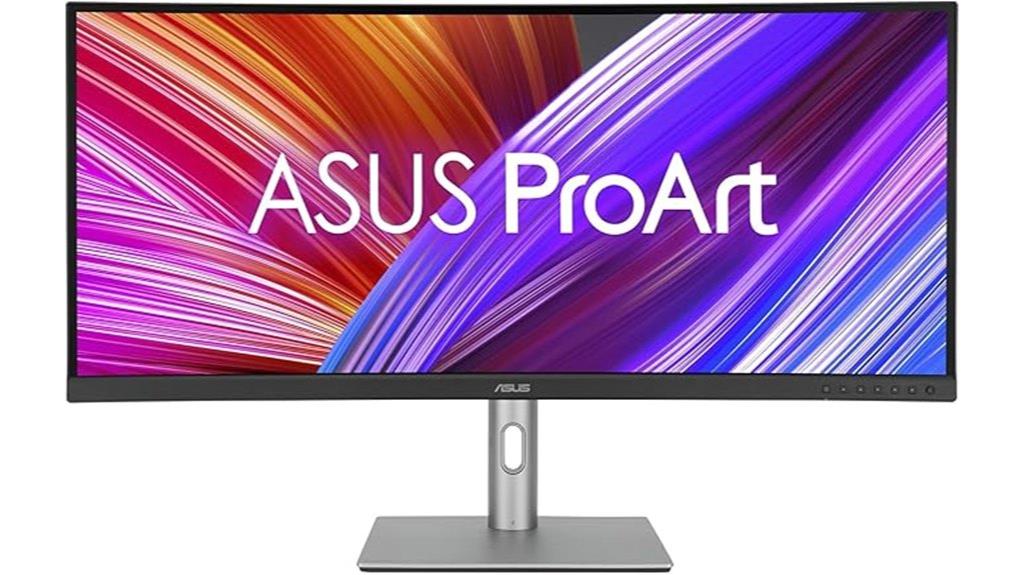
For professional video editors seeking wide color accuracy and a seamless editing experience, the ASUS ProArt 34” Ultrawide Curved HDR Monitor (PA34VCNV) stands out as an excellent choice. Its 34.1-inch curved display with a 3440×1440 resolution and 21:9 aspect ratio provides immersive visuals. The IPS panel offers wide viewing angles, factory calibration with Delta E <2, and 100% sRGB and Rec.709 coverage for precise color reproduction. Extensive connectivity options, including USB-C with 96W Power Delivery, HDMI, and LAN, support versatile workflows. While some users report connectivity and text crispness issues, its high color accuracy and ergonomic design make it a top pick for demanding editors.
Best For: professional video editors and creatives requiring high color accuracy and versatile connectivity in an immersive ultrawide curved display.
Pros:
- Factory calibrated with Delta E <2 and 100% sRGB/Rec.709 coverage for precise color reproduction
- Extensive connectivity options including USB-C with 96W Power Delivery, HDMI, USB hub, and LAN port
- Ergonomic design with tilt, swivel, and height adjustments for comfortable long-term use
Cons:
- Some users report static noise on dark screens and unstable USB-C connections, especially with MacBook Pros
- Text and image resolution may appear pixelated or less crisp at default settings, impacting clarity
- Connectivity instability and warranty service issues have been noted by certain users, especially with non-ASUS products
ASUS ProArt 32” 4K HDR Computer Monitor (PA32UCR-K)

Professional video editors demanding pinpoint color accuracy will find the ASUS ProArt 32” 4K HDR Monitor an excellent choice, thanks to its 99.5% Adobe RGB coverage and delta-E below 1. Its 32-inch 4K HDR display with mini-LED backlight delivers stunning brightness up to 1,000 cd/m² and supports HDR-10 and HLG formats, ensuring vibrant, true-to-life visuals. The IPS panel guarantees wide viewing angles and consistent color regardless of your position. With hardware calibration and included X-rite i1 Calibrator, you can fine-tune colors precisely. Versatile connectivity via USB-C and HDMI makes it compatible with various setups, perfect for professional color grading workflows.
Best For: creative professionals and video editors who require precise color accuracy and vibrant HDR visuals for their work.
Pros:
- Exceptional color fidelity with 99.5% Adobe RGB coverage and delta-E < 1
- Bright 1,000 cd/m² HDR display supporting HDR-10 and HLG formats
- Hardware calibration and included X-rite i1 Calibrator for precise color adjustments
Cons:
- Premium price point may be a consideration for budget-conscious users
- Large 32-inch size might not suit those with limited desk space
- Requires compatible hardware and setup for optimal performance
BenQ PD2705UA 27 4K UHD Monitor
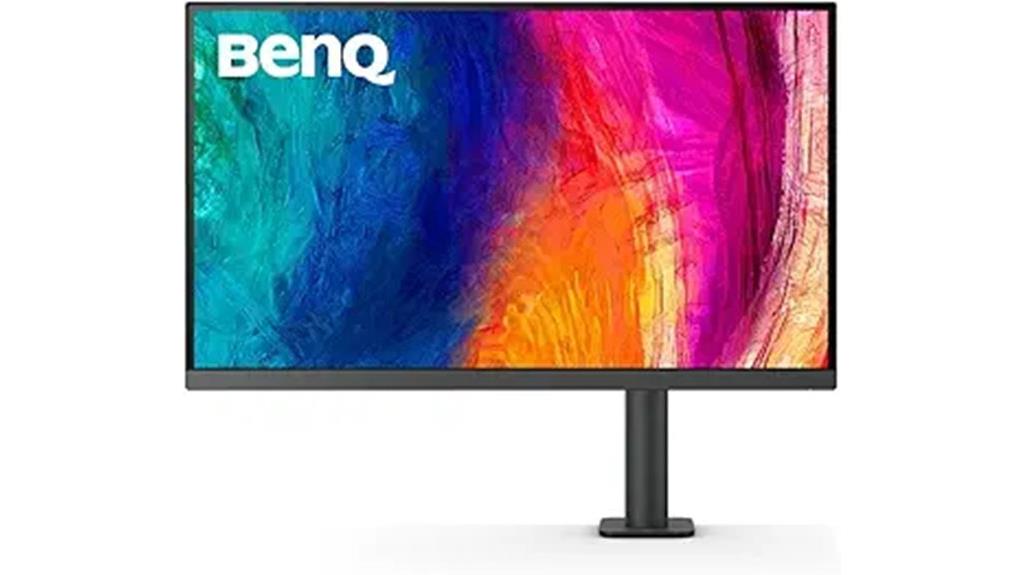
If you’re looking for a monitor that delivers exceptional color accuracy and sharp detail, the BenQ PD2705UA 27 4K UHD stands out as an excellent choice. Its 27-inch IPS panel with 3840×2160 resolution provides crisp, vibrant images, while its color coverage of 99% sRGB and Rec.709 ensures precise reproduction. Factory-calibrated and Pantone-verified, it offers reliable color accuracy with Delta E ≤ 3. It features versatile connectivity, including USB-C with up to 90W power delivery, and a flexible ergonomic stand with an Ergo Arm. Perfect for professional editing, this monitor combines excellent image quality with user-friendly features, making it a top pick for content creators.
Best For: professional photographers, graphic designers, and content creators seeking precise color accuracy and sharp 4K detail.
Pros:
- Excellent color accuracy with 99% sRGB and Rec.709 coverage, factory calibration, and Pantone verification
- Versatile connectivity options including USB-C with up to 90W power delivery and multiple USB 3.0 ports
- Ergonomic features with an adjustable Ergo Arm for optimal workspace customization
Cons:
- Premium price point may be a consideration for budget-conscious users
- Larger profile compared to some similar models, requiring ample desk space
- Limited gaming performance, not suitable for high-refresh-rate gaming or fast-paced content
Pro 15.6” 4K OLED Portable Monitor with Touchscreen

The Pro 15.6” 4K OLED Portable Monitor with Touchscreen stands out for creatives who need precise color accuracy on the go. Its 15.6-inch OLED panel with 3840×2160 resolution delivers sharp images and vibrant colors, perfect for detailed editing. With 100% AdobeRGB and a ΔE<2, it guarantees professional-grade color accuracy. The touchscreen with 10-point support and an intuitive Touch OSD menu makes adjustments effortless without side buttons. Lightweight and portable, it includes a metal stand, foldable cover, and stylus, making it ideal for travel or remote work. This monitor’s fast 1ms response time also benefits video editing and gaming.
Best For: creative professionals, graphic designers, and video editors who require precise color accuracy and portable high-resolution display on the go.
Pros:
- Ultra-sharp 4K OLED display with vibrant colors and professional-grade color accuracy (100% AdobeRGB, ΔE<2)
- Touchscreen with 10-point support and intuitive on-screen adjustments via Touch OSD menu, eliminating the need for side buttons
- Compact, lightweight design with included metal stand, foldable cover, and stylus, ideal for portability and travel
Cons:
- Higher price point due to advanced OLED and color calibration features
- Limited to 15.6 inches, which may be small for some professional workflows requiring larger screens
- The touchscreen functionality may not be as responsive or precise as dedicated professional drawing tablets
Calibrite ColorChecker Video XL (CCVPR-XL)

When working on larger scenes or capturing extensive shots from a distance, the Calibrite ColorChecker Video XL (CCVPR-XL) stands out as an ideal calibration tool. Its 21 x 14.75-inch target is perfect for wide shots, including landscapes, cityscapes, aerial footage, and events like concerts or sports. Designed for larger filming environments, it guarantees accurate color calibration across diverse scenarios. Whether you’re shooting with drones or capturing expansive scenes, this XL chart helps maintain consistent color quality, making it an essential tool for professional filmmakers who need reliable calibration in challenging, large-scale settings.
Best For: professional filmmakers and videographers working on large-scale, wide, or aerial shots who need accurate color calibration in expansive filming environments.
Pros:
- Large 21 x 14.75-inch size ideal for wide and aerial shots
- Designed specifically for extended scenes and larger filming environments
- Ensures consistent and accurate color calibration across diverse shooting scenarios
Cons:
- May be too large for small or confined shooting spaces
- Less portable due to its size and weight
- Higher cost compared to smaller calibration charts
InnoView 23.8″ Dual Portable Monitor with 4K Resolution

Designed for creative professionals on the go, the InnoView 23.8″ Dual Portable Monitor with 4K resolution delivers stunning visuals and accurate colors in a compact, foldable design. Its dual 23.8-inch IPS screens boast 3840×2160 resolution and 100% sRGB coverage, making it ideal for precise editing and color grading. The monitors are lightweight, foldable, and compatible with macOS and Windows, supporting multi-mode operation—extend, mirror, or ultra-wide canvas. Connectivity is straightforward with HDMI, USB-C, and DisplayPort, supporting dual 4K streams. While setup is quick, some users report occasional flickering and connectivity issues, especially with certain laptops. Overall, it’s a portable powerhouse for professionals needing high-quality visuals on the move.
Best For: creative professionals and remote workers who need portable, high-resolution dual monitors for editing, design, or entertainment on the go.
Pros:
- Stunning 4K UHD resolution with 100% sRGB coverage for accurate color reproduction.
- Lightweight, foldable design with versatile connectivity options including HDMI, USB-C, and DisplayPort.
- Supports multi-mode operation (extend, duplicate, ultra-wide) for flexible multi-monitor setups.
Cons:
- Occasional flickering and connectivity issues reported with certain laptops and docking stations.
- Short included cables can limit flexibility and ease of setup during travel.
- Heavier than some portable monitors, which may impact portability for frequent travelers.
EIZO EX 5 Colorimeter for Calibration for ColorEdge Series
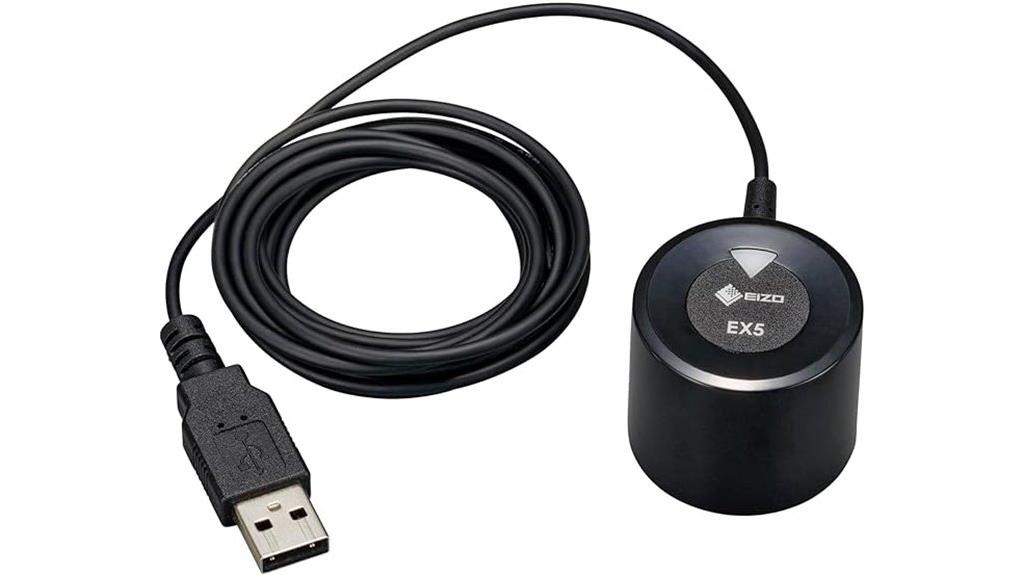
If you’re serious about color accuracy, the EIZO EX 5 Colorimeter stands out as an essential tool for calibrating EIZO’s ColorEdge monitors. It’s a professional device designed specifically for these screens, ensuring precise and reliable color calibration to maintain consistent, true-to-life images. Its compact size and durable build make it suitable for frequent use in professional settings. The EX 5 offers high-precision measurements, supports automation for ongoing calibration, and includes a remote control for easy operation. Customer feedback highlights its accuracy and reliability, though some find its small size challenging to handle. Overall, it’s a crucial accessory for any serious color editor.
Best For: professional photographers, graphic designers, and color-critical work environments seeking precise and reliable monitor calibration for EIZO’s ColorEdge series.
Pros:
- High-precision measurement ensuring accurate color calibration
- Supports automation for consistent ongoing calibration
- Compact, durable design suitable for frequent professional use
Cons:
- Small size can make handling and contact with monitors challenging
- Stiff cables may affect ease of setup and handling
- Requires compatibility with EIZO ColorEdge monitors, limiting broader use
ASUS ProArt 27” 1440P Professional Monitor (PA278CFRV)

The ASUS ProArt 27” 1440P Professional Monitor (PA278CFRV) stands out as an excellent choice for creative professionals who demand precise color accuracy. Its 2560×1440 IPS panel offers wide viewing angles, covering 95% DCI-P3 and 100% sRGB, ensuring vibrant, accurate colors. Factory-calibrated with a Delta E < 2, it guarantees high fidelity right out of the box. The monitor supports HDR400, a 100Hz VRR, and features versatile connectivity like USB-C with 96W Power Delivery. Its adjustable stand and extensive calibration options make it ideal for photo editing, video grading, and design work, all while maintaining excellent performance and color precision.
Best For: creative professionals and designers seeking a high-precision, color-accurate monitor for photo editing, video production, and graphic design.
Pros:
- Excellent color accuracy with 95% DCI-P3 and 100% sRGB coverage, factory-calibrated with Delta E < 2
- Versatile connectivity options including USB-C with 96W Power Delivery, HDMI, DisplayPort, and USB hub
- Adjustable stand with height and rotation features, plus support for HDR400 and 100Hz VRR for smooth visuals
Cons:
- Some users report color casting issues like green tint that may require calibration adjustments
- Occasional hardware failures and durability concerns, with limited support outside the US
- Possible difficulty in warranty claims internationally, leading to support limitations for non-US buyers
Calibrite ColorChecker Video XL with Case (CCVPR-XL-CS)

Looking for a dependable color calibration tool to guarantee consistent and accurate colors across your video projects? The Calibrite ColorChecker Video XL with Case is an excellent choice. It features a large, easy-to-use chart with chromatic, skin tone, gray, and illumination check chips, designed for quick and precise calibration. The included case is durable, portable, and versatile, making it simple to transport and store. Whether you’re on set or in post-production, this tool helps streamline your workflow, ensuring consistent exposure, accurate skin tones, and reliable color balance across multiple cameras and lighting conditions. It’s perfect for professionals demanding precision and speed.
Best For: professional videographers, cinematographers, and colorists seeking a reliable, portable tool for quick and accurate color calibration across multiple cameras and lighting conditions.
Pros:
- Large, easy-to-read chart with comprehensive color and gray chips for precise calibration
- Durable, portable case with versatile carrying options for on-set or in-studio use
- Facilitates faster, consistent workflow with optimized layout for vectorscopes and waveforms
Cons:
- Slightly higher price point compared to smaller calibration tools
- Heavier and bulkier than compact alternatives, which may impact portability for some users
- Requires manual handling and setup, not automated or digital, for calibration
Dell UltraSharp U3223QE 31.5 4K UHD WLED LCD Monitor – 16:9 – Black, Silver

For professional video editors prioritizing stunning color accuracy and sharp detail, the Dell UltraSharp U3223QE stands out as an ideal choice. Its 31.5-inch 4K UHD display delivers over 8 million pixels, ensuring crisp visuals and ample workspace. The IPS Black technology offers a remarkable contrast ratio of 2000:1, producing vivid colors and deep blacks perfect for color grading. With 98% DCI-P3 coverage and VESA DisplayHDR™ 400 support, it guarantees true-to-life hues. Connectivity is versatile, featuring USB-C, HDMI, and DisplayPort, while ergonomic adjustments enhance comfort. Overall, this monitor combines excellent color fidelity, sharpness, and flexibility, making it a top pick for demanding editing workflows.
Best For: professional video editors and graphic designers seeking precise color accuracy, sharp detail, and versatile connectivity in a high-resolution monitor.
Pros:
- Exceptional 4K UHD resolution with over 8 million pixels for detailed visuals and ample workspace
- 2000:1 contrast ratio with IPS Black technology delivers vivid colors and deep blacks
- Supports VESA DisplayHDR™ 400 and 98% DCI-P3 coverage for true-to-life hues and professional-grade color fidelity
Cons:
- Bulky stand may require significant desk space and adjustability considerations
- Limited built-in features like speakers or microphones, which could enhance user experience
- Higher price point reflecting professional-grade features, potentially less accessible for casual users
ASUS ProArt 27” 5K HDR Monitor (PA27JCV)

If you need a high-precision display for professional color grading, the ASUS ProArt 27” 5K HDR Monitor (PA27JCV) stands out with its stunning 5120 x 2880 resolution and factory-calibrated color accuracy. It features an IPS panel with 178° viewing angles and covers 99% DCI-P3, 100% sRGB, and 95% Adobe RGB, ensuring vibrant, true-to-life colors. The monitor automatically adjusts brightness and color temperature based on ambient light, maintaining consistent image quality. With a sturdy adjustable stand, USB-C with 96W power delivery, and multi-device management, it’s a versatile choice for professional creators who demand precision and flexibility.
Best For: professional content creators and color grading specialists who require ultra-high resolution and precise color accuracy for their workflows.
Pros:
- Exceptional 5K resolution with vibrant, accurate colors thanks to wide color gamut and factory calibration.
- Versatile connectivity options including USB-C with 96W power delivery, HDMI, and Thunderbolt 3/4, simplifying setup.
- Built-in ambient light sensors automatically adjust brightness and color temperature for consistent image quality.
Cons:
- The stand can be wobbly, affecting stability for some users.
- Lacks integrated webcam and microphone, requiring additional accessories for videoconferencing.
- The speakers are of poor quality, unsuitable for multimedia use.
ViewSonic VP3881 38-Inch Ultrawide IPS Monitor
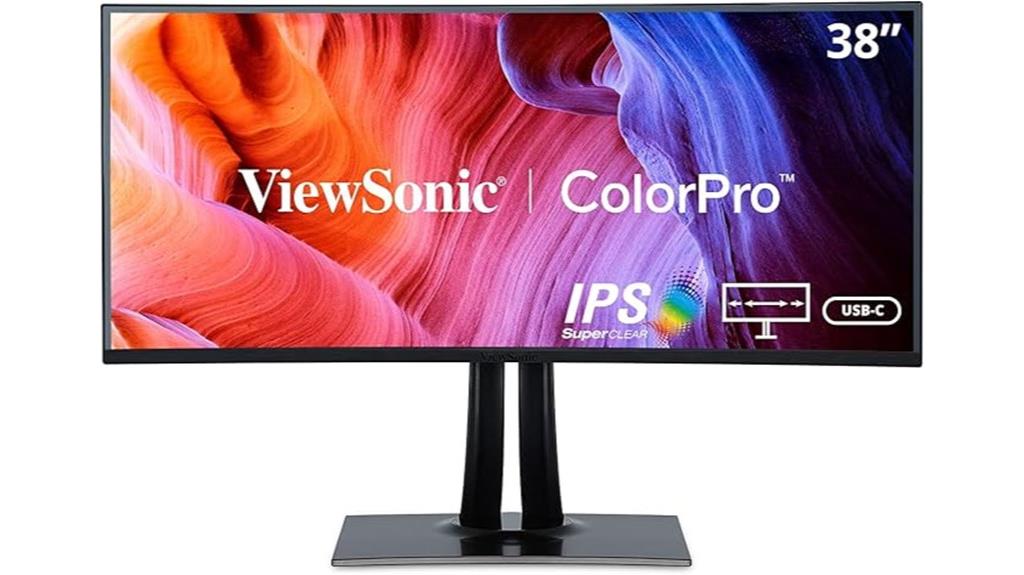
The ViewSonic VP3881 38-Inch Ultrawide IPS Monitor stands out as an excellent choice for professional video editors who need expansive screen real estate and precise color accuracy. Its 38-inch curved display with a 3840×1600 resolution offers immersive panoramic viewing, ideal for multitasking and detailed editing. With 100% sRGB, Rec. 709, and a 14-bit 3D LUT, it delivers consistent, vibrant colors and smooth gradients. The hardware calibration option guarantees color precision over time. Support for HDR10 and multiple connectivity options make it versatile for various workflows. While its size and setup can be cumbersome, its high-quality visuals and ergonomic design make it a top contender.
Best For: professional video editors, graphic designers, and content creators seeking expansive, color-accurate ultrawide displays for detailed multitasking and editing work.
Pros:
- Exceptional color accuracy with 100% sRGB, Rec. 709, and hardware calibration options for precise color control
- Immersive 38-inch curved ultrawide display with high resolution (3840×1600) for expansive workspace and multitasking
- Versatile connectivity including USB-C, HDMI, and DisplayPort, supporting various devices and workflows
Cons:
- Heavy stand and large size can make setup cumbersome and require a stable workspace
- Initial calibration and setup may be time-consuming; some users report recognition issues with certain cables
- Limited volume control options via monitor, with basic audio support and potential wobble or attachment difficulty
Factors to Consider When Choosing Color-Grading Monitors for Video Editors

When selecting a color-grading monitor, I focus on key factors like color gamut coverage and calibration accuracy to guarantee true-to-life colors. Screen uniformity and connectivity options also matter, as they impact consistency and workflow flexibility. Finally, ergonomic adjustments help me work comfortably during long editing sessions.
Color Gamut Coverage
Choosing a monitor with wide color gamut coverage is fundamental for professional color grading because it guarantees accurate and vibrant color reproduction. Monitors that cover 99% Adobe RGB or 100% sRGB ensure I can see a broad spectrum of colors, which is crucial for detailed adjustments. Coverage of standards like Rec. 709 and DCI-P3 is indispensable for broadcast and cinematic projects, maintaining consistency across media. I always verify a monitor’s color gamut through factory calibration reports or specifications to confirm it meets industry standards. Higher color gamut coverage allows for more saturated, lifelike colors, which elevates the quality of my high-end editing projects. Without this, I risk losing color fidelity, especially when working across different devices and formats.
Calibration Accuracy
Calibrating a monitor accurately is essential for ensuring my color grading work is true to life and consistent across different projects. Monitors with factory calibration and low Delta E values (preferably below 2) help me get precise colors right out of the box. Regular calibration with professional tools like colorimeters or spectrophotometers is crucial to maintain that accuracy over time, especially as displays age. Features like hardware calibration support and built-in calibration sensors make this process easier and more reliable. Accurate calibration impacts my workflow by ensuring the colors I see are true and will translate correctly across different devices and media. This consistency is critical for delivering professional-quality results that stand up in any viewing environment.
Screen Uniformity
A key factor in selecting a color-grading monitor is its screen uniformity, which guarantees consistent brightness and color accuracy across the entire display. High uniformity means you won’t see shifts in color or brightness from the center to the edges or corners, saving you time on adjustments and corrections. This consistency is measured by evaluating how much brightness and chromaticity vary across the screen. Professional-grade monitors often include built-in calibration tools or uniformity correction features to help maintain this stability. Variations in uniformity can lead to inaccurate color grading, so regular calibration and choosing displays with proven uniformity performance are essential. Ultimately, a monitor with excellent screen uniformity ensures your work remains precise, reliable, and true to your creative vision.
Connectivity Options
To guarantee seamless integration with your existing equipment, it’s crucial to take into account the connectivity options available on a color-grading monitor. Look for multiple ports like HDMI, DisplayPort, USB-C, and Thunderbolt to support various devices and workflows. High-bandwidth connections, such as USB-C with Power Delivery and fast data transfer, are essential for professional video editing setups. Verify that the monitor’s ports are compatible with your hardware, whether you’re using Mac or Windows systems. Daisy-chaining via DisplayPort or Thunderbolt can help expand your multi-monitor setup efficiently. Additionally, dedicated hardware calibration ports or compatibility with calibration tools ensure you can maintain precise color accuracy across different connection types. These features keep your workflow smooth and your color grading consistent.
Ergonomic Adjustments
When selecting a color-grading monitor, ergonomic adjustments play a vital role in creating a comfortable workspace. Features like adjustable height, tilt, swivel, and pivot enable me to find the perfect viewing angle, reducing strain during long editing sessions. Proper ergonomic setup, such as aligning the monitor’s top edge with my eye level and maintaining a consistent distance, helps minimize neck, back, and eye fatigue. Monitors with customizable adjustments allow me to optimize my workspace for better color accuracy and detailed work, which boosts my workflow efficiency. Versatile adjustment options also accommodate different workspace configurations and personal preferences, lowering the risk of repetitive strain injuries. Prioritizing these ergonomic features ensures I stay comfortable and focused while producing high-quality video content.
Frequently Asked Questions
How Does Monitor Calibration Impact Color Accuracy in Professional Editing?
Monitor calibration is vital for color accuracy in professional editing because it guarantees my display shows true-to-life colors consistently. When I calibrate my monitor regularly, it eliminates color shifts and inconsistencies, allowing me to trust what I see. This precision helps me achieve the perfect look for my projects, making sure my edits look great across different screens and mediums. Without calibration, my work could be off in color, affecting the final quality.
What Are the Advantages of OLED Versus IPS Panels for Color Grading?
OLED panels offer stunning contrast and vibrant colors, making them ideal for detailed color grading. They provide deeper blacks and better color accuracy, which helps me spot subtle differences in my footage. IPS panels, on the other hand, excel in color consistency across wide viewing angles and are generally more affordable. For professional editing, I prefer OLED for its superior image quality, but IPS can be a great choice for versatility and cost-effectiveness.
How Important Is Screen Size Versus Resolution in Color-Critical Work?
Screen size is vital for color-critical work because it affects your ability to see fine details and make precise adjustments. Resolution matters too, but a larger screen with good resolution helps you view more of your timeline and color nuances comfortably. I find a balance is best—something around 27 to 32 inches with 4K resolution—so you can work accurately without straining your eyes or missing subtle color shifts.
Can Consumer-Grade Monitors Meet Professional Color Grading Standards?
They say you get what you pay for, and honestly, consumer-grade monitors often can’t meet professional color grading standards. While some high-end models are impressive, true accuracy, consistent color, and calibration tools are usually lacking in cheaper screens. If you’re serious about color work, investing in a professional-grade monitor is worth it—otherwise, you risk compromising your creative vision and final quality.
What Role Does HDR Support Play in Selecting a Grading Monitor?
HDR support is vital when choosing a grading monitor because it allows me to see a broader range of colors and contrast, making my videos look more vibrant and true to life. With HDR, I can accurately evaluate how my footage will appear on various screens, ensuring consistent quality. It’s an essential feature for professional grading, helping me deliver polished, visually stunning content that stands out.
Conclusion
Choosing the right color-grading monitor can truly elevate your editing game, making your work look its best. While it might seem overwhelming at first, focusing on the key features and your specific needs can make the process smoother. Remember, no monitor is perfect, but with a little patience and research, you’ll find a great fit. Trust your instincts, and soon enough, your edits will shine with confidence and clarity.










